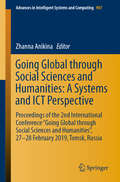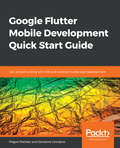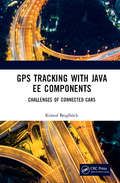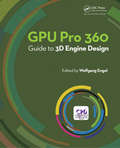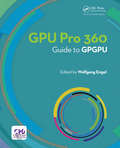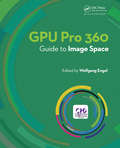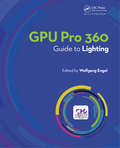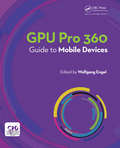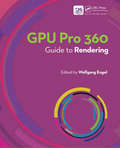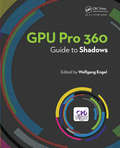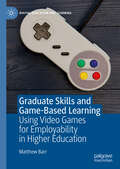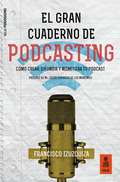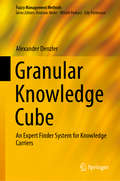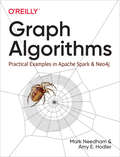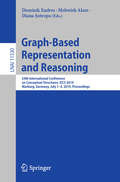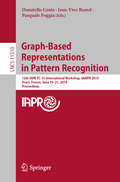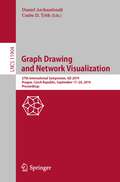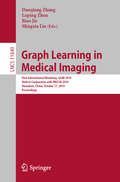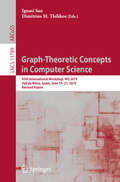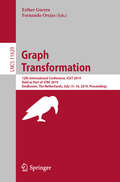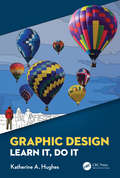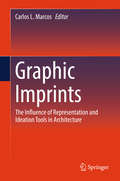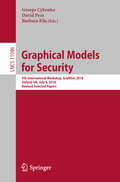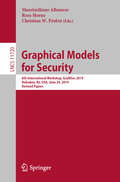- Table View
- List View
Going Global through Social Sciences and Humanities: Proceedings of the 2nd International Conference “Going Global through Social Sciences and Humanities”, 27-28 February 2019, Tomsk, Russia (Advances in Intelligent Systems and Computing #907)
by Zhanna AnikinaThis book presents contributions submitted to the 2nd international conference Going Global through Social Sciences and Humanities (GGSSH 2019) held in Tomsk, Russia on 27–28 February 2019. The conference focused on such issues as interdisciplinary pedagogy, language teaching and learning, cultural studies and linguistics, particularly highlighting global academic integration and professional development for research. As such, the event provided a platform for discussions and sharing publication activities, to help Russian academics to take first steps toward global research.Showcasing the ongoing Russian research in focus areas, this book is of interest to a diverse academic audience working in social sciences and humanities, particularly those from the post-Soviet countries.
Google Flutter Mobile Development Quick Start Guide: Get up and running with iOS and Android mobile app development
by Prajyot Mainkar Salvatore GiordanoA fast-paced guide to get you started with cross-platform mobile application development with Google Flutter Key Features Understand the fundamentals of Flutter and get started with cross-platform mobile app development. Learn about different widgets in Flutter and understand the concepts of Routing and Navigating. Work with Platform specific code to use Native features and deploy your application on iOS and Android. Book Description Flutter is a cross-platform mobile application development framework. It uses the Dart programming language, which was created by Google, and aims to make development easier, faster, and more efficient. This book is going to be your guide, from introducing Flutter to successfully developing a cross platform application. In the first few chapters, we will learn what Flutter is and how to get started with it. We will also take a dive into the widgets world, explore the widget catalog, and learn how to navigate through it. In the next few chapters, we will widen our horizon by learning about networking and accessibility with Flutter. We'll learn what Silvers are and how to use them, and we'll also learn how to use constraints and animations. Before we take a look at how to deploy our applications in Flutter, we will use Firebase for cloud messaging and remote configuration. By the end of the book, you will have learned everything you need to know to get started with your journey of cross-platform mobile development with Flutter. What you will learn Take a tour through the widget catalog Route and navigate through the widgets Use listview and scroll widgets Gain knowledge on networking with Flutter and Dart Build and publish plugins to pub.dart.com Use Firebase cloud messaging and remote configuration Build and release your application on Android and iOS Who this book is for This book is for developers who are willing to learn flutter and develop cross-platform applications
GPS Tracking with Java EE Components: Challenges of Connected Cars
by Kristof BeiglböckGPS Tracking with Java EE Components: Challenges of Connected Cars highlights how the self-driving car is actually changing the automotive industry, from programing embedded software to hosting services and data crunching, in real time, with really big data. <P><P>The book analyzes how the challenges of the Self Driving Car (SDC) exceed the limits of a classical GPS Tracking System (GTS.) It provides a guidebook on setting up a tracking system by customizing its components. It also provides an overview of the prototyping and modeling process, and how the reader can modify this process for his or her own software. <P><P>Every component is introduced in detail and includes a number of design decisions for development. The book introduces Java EE (JEE) Modules, and shows how they can be combined to a customizable GTS, and used as seed components to enrich existing systems with live tracking. <P><P>The book also explores how to merge tracking and mapping to guide SDCs, and focuses on client server programming to provide useful information. It also discusses the challenges involved with the live coordination of moving cars. <P><P>This book is designed to aid GTS developers and engineers in the automotive industry. It can also help Java Developers, not only interested in GPS Tracking, but in modern software design from many individual modules. Source code and sample applications will be available on the book's website.
GPU Pro 360 Guide to 3D Engine Design
by Wolfgang EngelWolfgang Engel’s GPU Pro 360 Guide to 3D Engine Design gathers all the cutting-edge information from his previous seven GPU Pro volumes into a convenient single source anthology that covers the design of a 3D engine. This volume is complete with articles by leading programmers that focus on various aspects of 3D engine design such as quality and optimization as well as high-level architecture. GPU Pro 360 Guide to 3D Engine Design is comprised of ready-to-use ideas and efficient procedures that can help solve many computer graphics programming challenges that may arise. <P><P>Key Features: <li>Presents tips & tricks on real-time rendering of special effects and visualization data on common consumer software platforms such as PCs, video consoles, mobile devices <li>Covers specific challenges involved in creating games on various platforms <li>Explores the latest developments in rapidly evolving field of real-time rendering <li>Takes practical approach that helps graphics programmers solve their daily challenges
GPU PRO 360 Guide to GPGPU
by Wolfgang EngelWolfgang Engel’s GPU Pro 360 Guide to GPGPU gathers all the cutting-edge information from his previous seven GPU Pro volumes into a convenient single source anthology that covers general purpose GPU. This volume is complete with 19 articles by leading programmers that focus on the techniques that go beyond the normal pixel and triangle scope of GPUs and take advantage of the parallelism of modern graphics processors to accomplish such tasks. GPU Pro 360 Guide to GPGPU is comprised of ready-to-use ideas and efficient procedures that can help solve many computer graphics programming challenges that may arise. <P><P>Key Features: <li>Presents tips & tricks on real-time rendering of special effects and visualization data on common consumer software platforms such as PCs, video consoles, mobile devices <li>Covers specific challenges involved in creating games on various platforms <li>Explores the latest developments in rapidly evolving field of real-time rendering <li>Takes practical approach that helps graphics programmers solve their daily challenges
GPU Pro 360 Guide to Image Space
by Wolfgang EngelWolfgang Engel’s GPU Pro 360 Guide to Image Space gathers all the cutting-edge information from his previous seven GPU Pro volumes into a convenient single source anthology that covers various algorithms that operate primarily in image space. This volume is complete with 15 articles by leading programmers speaks to the power and convenience of working in screen space. GPU Pro 360 Guide to Image Space is comprised of ready-to-use ideas and efficient procedures that can help solve many computer graphics programming challenges that may arise. <P><P> Key Features: <li>Presents tips & tricks on real-time rendering of special effects and visualization data on common consumer software platforms such as PCs, video consoles, mobile devices <li>Covers specific challenges involved in creating games on various platforms <li>Explores the latest developments in rapidly evolving field of real-time rendering <li>Takes practical approach that helps graphics programmers solve their daily challenges
GPU Pro 360 Guide to Lighting
by Wolfgang EngelWolfgang Engel’s GPU Pro 360 Guide to Lighting gathers all the cutting-edge information from his previous seven GPU Pro volumes into a convenient single source anthology on lighting. This volume is complete with 24 articles by leading programmers that describes rendering techniques of global illumination effects suited for direct rendering applications in real time. GPU Pro 360 Guide to Lighting is comprised of ready-to-use ideas and efficient procedures that can help solve many computer graphics programming challenges that may arise. <P><P>Key Features: <li>Presents tips and tricks on real-time rendering of special effects and visualization data on common consumer software platforms such as PCs, video consoles, and mobile devices <li>Covers specific challenges involved in creating games on various platforms <li>Explores the latest developments in the rapidly evolving field of real-time rendering <li>Takes a practical approach that helps graphics programmers solve their daily challenges
GPU Pro 360 Guide to Mobile Devices
by Wolfgang EngelWolfgang Engel’s GPU Pro 360 Guide to Mobile Devices gathers all the cutting-edge information from his previous seven GPU Pro volumes into a convenient single source anthology that covers computer graphics in mobile devices. This volume is complete with 18 articles by leading programmers that focus on the ability of graphics processing units to process and generate geometry in exciting ways. GPU Pro 360 Guide to Mobile Devices is comprised of ready-to-use ideas and efficient procedures that can help solve many computer graphics programming challenges that may arise. <P><P>Key Features: <li>Presents tips & tricks on real-time rendering of special effects and visualization data on common consumer software platforms such as PCs, video consoles, mobile devices <li>Covers specific challenges involved in creating games on various platforms <li>Explores the latest developments in rapidly evolving field of real-time rendering <li>Takes practical approach that helps graphics programmers solve their daily challenges
GPU Pro 360 Guide to Rendering
by Wolfgang EngelWolfgang Engel’s GPU Pro 360 Guide to Rendering gathers all the cutting-edge information from his previous seven GPU Pro volumes into a convenient single source anthology that covers real-time rendering. This volume is complete with 32 articles by leading programmers that focus on the ability of graphics processing units to process and generate rendering in exciting ways. GPU Pro 360 Guide to Rendering is comprised of ready-to-use ideas and efficient procedures that can help solve many rendering programming challenges that may arise. Key Features: Presents tips and tricks on real-time rendering of special effects and visualization data on common consumer software platforms such as PCs, video consoles, and mobile devices Covers specific challenges involved in creating games on various platforms Explores the latest developments in the rapidly evolving field of real-time rendering Takes a practical approach that helps graphics programmers solve their daily challenges
GPU Pro 360 Guide to Shadows
by Wolfgang EngelWolfgang Engel’s GPU Pro 360 Guide to Shadows gathers all the cutting-edge information from his previous seven GPU Pro volumes into a convenient single source anthology that covers various algorithms that are used to generate shadow data. This volume is complete with 15 articles by leading programmers that focus on achieving good visual results in rendering shadows. GPU Pro 360 Guide to Shadows is comprised of ready-to-use ideas and efficient procedures that can help solve many computer graphics programming challenges that may arise. <P><P>Key Features: <li>Presents tips & tricks on real-time rendering of special effects and visualization data on common consumer software platforms such as PCs, video consoles, mobile devices <li>Covers specific challenges involved in creating games on various platforms <li>Explores the latest developments in rapidly evolving field of real-time rendering <li>Takes practical approach that helps graphics programmers solve their daily challenges
Grab Life by the Balls: And Other Life Lessons from The Good Advice Cupcake
by Loryn Brantz Kyra KupetskyFollow along with The Good Advice Cupcake as she doles out razor-smart, hilarious, and shocking advice on everything from career goals to falling in love! The Good Advice Cupcake -- or Cuppy, to those in the know -- may be cute, but she's not afraid to grab life by the balls! In this charming gift book, Cuppy shares her tried-and-true wisdom on everything from love and money, to self-care and fashion, to career and happiness, and the crazy, sticky things in between -- all the while managing to look completely adorable and delicious. Whether she's advising you to take more naps or fit cheese into your diet, you don't want to miss a minute of advice from everyone's favorite sassy cupcake.
Graduate Skills and Game-Based Learning: Using Video Games for Employability in Higher Education (Digital Education and Learning)
by Matthew BarrThis book explores the efficacy of game-based learning to develop university students’ skills and competencies. While writing on game-based learning has previously emphasised the use of games developed specifically for educational purposes, this book fills an important gap in the literature by focusing on commercial games such as World of Warcraft and Minecraft. Underpinned by robust empirical evidence, the author demonstrates that the current negative perception of video games is ill-informed, and in fact these games can be important tools to develop graduate skills related to employability. Speaking to very current concerns about the employability of higher education graduates and the skills that university is intended to develop, this book also explores the attitudes to game-based learning as expressed by instructors, students and game developers.
El Gran Cuaderno de Podcasting: Cómo crear, difundir y monetizar tu podcast
by Francisco IzuzquizaEl Gran Cuaderno de Podcasting muestra todo lo necesario para aprender a crear un podcast, publicarlo y darlo a conocer para convertirse en un podcaster profesional. Francisco Izuzquiza, locutor y consultor de radio y podcasts, describe las claves y las herramientas imprescindibles para iniciarnos en el mundo de los podcasts y los consejos y aspectos técnicos para usuarios más avanzados o, incluso, expertos. Desde la elección del tema del podcast, su planificación, los métodos de grabación o el micrófono más recomendable según nuestras necesidades y presupuesto, a los programas de grabación, el alojamiento del podcast, la medición de escuchas, los rankings, la música, los derechos de autor y la monetización. El auge de los podcasts supone un reto apasionante para todo aquel que quiere acercase a esta actividad desde el mundo de la radio o desde cualquier otro sector. En este libro el autor comparte su experiencia y todo lo aprendido hasta conseguir dedicarse al podcasting de forma profesional.
Granular Knowledge Cube: An Expert Finder System for Knowledge Carriers (Fuzzy Management Methods)
by Alexander DenzlerThis book introduces a novel type of expert finder system that can determine the knowledge that specific users within a community hold, using explicit and implicit data sources to do so. Further, it details how this is accomplished by combining granular computing, natural language processing and a set of metrics that it introduces to measure and compare candidates’ suitability. The book describes profiling techniques that can be used to assess knowledge requirements on the basis of a given problem statement or question, so as to ensure that only the most suitable candidates are recommended. The book brings together findings from natural language processing, artificial intelligence and big data, which it subsequently applies to the context of expert finder systems. Accordingly, it will appeal to researchers, developers and innovators alike.
Graph Algorithms: Practical Examples in Apache Spark and Neo4j
by Mark Needham Amy E. HodlerDiscover how graph algorithms can help you leverage the relationships within your data to develop more intelligent solutions and enhance your machine learning models. You’ll learn how graph analytics are uniquely suited to unfold complex structures and reveal difficult-to-find patterns lurking in your data. Whether you are trying to build dynamic network models or forecast real-world behavior, this book illustrates how graph algorithms deliver value—from finding vulnerabilities and bottlenecks to detecting communities and improving machine learning predictions.This practical book walks you through hands-on examples of how to use graph algorithms in Apache Spark and Neo4j—two of the most common choices for graph analytics. Also included: sample code and tips for over 20 practical graph algorithms that cover optimal pathfinding, importance through centrality, and community detection.Learn how graph analytics vary from conventional statistical analysisUnderstand how classic graph algorithms work, and how they are appliedGet guidance on which algorithms to use for different types of questionsExplore algorithm examples with working code and sample datasets from Spark and Neo4jSee how connected feature extraction can increase machine learning accuracy and precisionWalk through creating an ML workflow for link prediction combining Neo4j and Spark
Graph-Based Representation and Reasoning: 24th International Conference on Conceptual Structures, ICCS 2019, Marburg, Germany, July 1–4, 2019, Proceedings (Lecture Notes in Computer Science #11530)
by Dominik Endres Mehwish Alam Diana ŞotropaThis book constitutes the proceedings of the 24th International Conference on Conceptual Structures, ICCS 2019, held in Marburg, Germany, in July 2019. The 14 full papers and 6 short papers presented were carefully reviewed and selected from 29 submissions. The proceedings also include one of the two invited talks. The papers focus on the representation of and reasoning with conceptual structures in a variety of contexts. ICCS 2019's theme was entitled "Graphs in Human and Machine Cognition."
Graph-Based Representations in Pattern Recognition: 12th IAPR-TC-15 International Workshop, GbRPR 2019, Tours, France, June 19–21, 2019, Proceedings (Lecture Notes in Computer Science #11510)
by Donatello Conte Jean-Yves Ramel Pasquale FoggiaThis book constitutes the refereed proceedings of the 12th IAPR-TC-15 International Workshop on Graph-Based Representation in Pattern Recognition, GbRPR 2019, held in Tours, France, in June 2019.The 22 full papers included in this volume together with an invited talk were carefully reviewed and selected from 28 submissions. The papers discuss research results and applications at the intersection of pattern recognition, image analysis, and graph theory. They cover topics such as graph edit distance, graph matching, machine learning for graph problems, network and graph embedding, spectral graph problems, and parallel algorithms for graph problems.
Graph Drawing and Network Visualization: 27th International Symposium, GD 2019, Prague, Czech Republic, September 17–20, 2019, Proceedings (Lecture Notes in Computer Science #11904)
by Daniel Archambault Csaba D. TóthThis book constitutes the refereed proceedings of the 27th International Symposium on Graph Drawing and Network Visualization, GD 2019, held in Prague, Czech Republic, in September 2019.The 42 papers and 12 posters presented in this volume were carefully reviewed and selected from 113 submissions. They were organized into the following topical sections: Cartograms and Intersection Graphs, Geometric Graph Theory, Clustering, Quality Metrics, Arrangements, A Low Number of Crossings, Best Paper in Track 1, Morphing and Planarity, Parameterized Complexity, Collinearities, Topological Graph Theory, Best Paper in Track 2, Level Planarity, Graph Drawing Contest Report, and Poster Abstracts.
Graph Learning in Medical Imaging: First International Workshop, GLMI 2019, Held in Conjunction with MICCAI 2019, Shenzhen, China, October 17, 2019, Proceedings (Lecture Notes in Computer Science #11849)
by Daoqiang Zhang Luping Zhou Biao Jie Mingxia LiuThis book constitutes the refereed proceedings of the First International Workshop on Graph Learning in Medical Imaging, GLMI 2019, held in conjunction with MICCAI 2019 in Shenzhen, China, in October 2019. The 21 full papers presented were carefully reviewed and selected from 42 submissions. The papers focus on major trends and challenges of graph learning in medical imaging and present original work aimed to identify new cutting-edge techniques and their applications in medical imaging.
Graph-Theoretic Concepts in Computer Science: 45th International Workshop, WG 2019, Vall de Núria, Spain, June 19–21, 2019, Revised Papers (Lecture Notes in Computer Science #11789)
by Ignasi Sau Dimitrios M. ThilikosThis book constitutes the revised papers of the 45th International Workshop on Graph-Theoretic Concepts in Computer Science, WG 2019, held in Vall de Núria, Spain, in June 2019. The 29 full papers presented in this volume were carefully reviewed and selected from 87 submissions. They cover a wide range of areas, aiming at connecting theory and applications by demonstrating how graph-theoretic concepts can be applied in various areas of computer science. Another focus is on presenting recent results and on identifying and exploring promising directions of future research.
Graph Transformation: 12th International Conference, ICGT 2019, Held as Part of STAF 2019, Eindhoven, The Netherlands, July 15–16, 2019, Proceedings (Lecture Notes in Computer Science #11629)
by Esther Guerra Fernando OrejasThis book constitutes the refereed proceedings of the 12th International Conference on Graph Transformation, ICGT 2019, held as part of STAF 2019, in Eindhoven, The Netherlands, in July2019. The 12 research papers and 1 tool paper presented in this book were carefully reviewed and selected from 22 submissions. The papers deal with the following topics: Theory, Analysis and Verification, Tools and Applications, and Transformation Rules Construction and Matching.
Graphic Design: Learn It, Do It
by Katherine A. HughesGraphic Design: Learn It, Do It is introduction to the fundamentals of graphic design and the Adobe Creative Cloud applications used to put these concepts into practice. This book is intended for production-oriented audiences, those interested in the what, why and how of graphic design. The "what" is effective graphic design, a visual solution created using the design principles that stands out in a crowded marketplace. This discussion includes color theory, typography and page layout. Focus on the "why" of design begins with the reasons why we communicate. Attention is paid to the purpose of the visual solution and to its audiences. The conversation highlights output options (print vs. onscreen) and their related file properties. The "how" of design addresses the stages of production and use of Adobe Photoshop CC, Illustrator CC and InDesign CC to translate an idea into a visual solution. Following an overview of each application and its uses, step-by-step exercises are provided to foster familiarity with each application’s workspace and its tools. These exercises provide opportunities to implement the design principles and to produce examples of work for a design portfolio. Key Features: Content based on over a decade’s worth of experience teaching graphic design Contemporary examples and online references Guided exercises for working in the Adobe Creative Cloud applications, Photoshop CC, Illustrator CC and InDesign CC Accompanying exercise files and supporting materials available for download from the book’s companion website Discussion questions and activities included at the end of chapters to expand the presented topics
Graphic Imprints: The Influence Of Representation And Ideation Tools In Architecture
by Carlos L. MarcosThis is the Proceedings of the International Congress of Graphic Design in Architecture, EGA 2018, held in Alicante, Spain, May 30-June 1, 2018. About 200 professionals and researchers from 18 different countries attended the Congress. This book will be of interest to researchers in the field of architecture and Engineering. Topics discussed are Innovations in Architecture, graphic design and architecture, history and heritage among others.
Graphical Models for Security: 5th International Workshop, GraMSec 2018, Oxford, UK, July 8, 2018, Revised Selected Papers (Lecture Notes in Computer Science #11086)
by George Cybenko David Pym Barbara FilaThis book constitutes revised selected papers from the 5th International Workshop on Graphical Models for Security, GraMSec 2018, held in Oxford, UK, in July 2018. The 7 full papers presented in this volume were carefully reviewed and selected from 21 submissions. The book also contains one invited talk. The contributions deal with the latest research and developments on graphical models for security.
Graphical Models for Security: 6th International Workshop, GraMSec 2019, Hoboken, NJ, USA, June 24, 2019, Revised Papers (Lecture Notes in Computer Science #11720)
by Massimiliano Albanese Ross Horne Christian W. ProbstThis book constitutes revised papers from the 6th International Workshop on Graphical Models for Security, GraMSec 2019, held in Hoboken, NJ, USA, in June 2019. The 8 full papers presented in this volume were carefully reviewed and selected from 15 submissions. The book also contains two invited talk. The contributions deal with the latest research and developments on graphical models for security.
